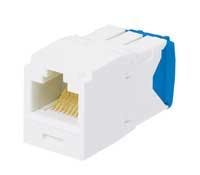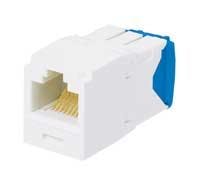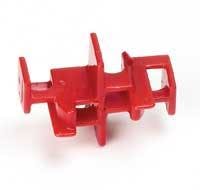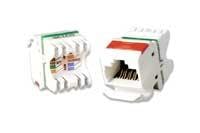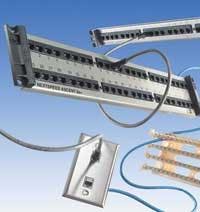A new breed of UTP connectors has emerged as vendors introduce product lines they predict will comply with yet-to-be-standardized Augmented Category 6 specifications.
Defining an Augmented Category 6 UTP cabling and component specification to support 10-Gigabit Ethernet over 100 meters involves extrapolating performance to 500 MHz and minimizing the new critical alien crosstalk (ANEXT) parameter. For UTP connectors (see table, page 56), this means new designs and strategies that improve the overall relationship between the crosstalk-adding plug and the compensating jack, and that reduce undesired noise coupling from adjacent connectors- both in the closet and at the workstation.
Too high to compensate
“Unlike cable that inherently has linear performance, it’s difficult for connectors to comply when the performance parameters are extrapolated and tested to a higher frequency,” says Valerie Rybinski, global sales engineer, The Siemon Company (www.siemon.com). “Because there’s no compensation in the plug, it will stay the same. Therefore, to maintain electrical performance out to 500 MHz, it’s the jacks that have to be reengineered.”
In the plug and jack relationship, the plug intrinsically emits noise and the jack compensates for that noise. The noise generated by the plug is caused by two phenomena. First, the plug’s blades are positioned in line, enabling them to send and receive signals to and from each other like tiny antennas. Second, because Pair 2 (568A) or Pair 3 (568B) is split around Pair 1, some of the cancellation by wire twist is offset, and so crosstalk is increased.
“The crosstalk at the plug level must be compensated for in the jack,” explains Andre Mouton, product line manager for Belden CDT Networking (www.beldenibdn.com). “The problem is that compensation cannot take place until the signal has reached a given point on the PCB in the jack.”
The distance between the point of noise creation in the plug and point of compensation in the jack is called the delay effect-which is directly correlated to the physical distance of the plug’s pins and the distance to the point of compensation in the jack. At lower frequencies, the delay effect is not critical to performance. At frequencies above 300 MHz, however, the delay effect causes near-end crosstalk (NEXT).
“The goal is to have the two opposing signals equal zero, but there is a slight shift, which is proportional to the delay,” says Mouton. “At higher frequencies, this shift is greater, and the compensation becomes inadequate. That is why NEXT problems encountered at higher frequencies are caused by the connectivity.”
At the 500 MHz frequency proposed for 10-Gigabit Ethernet, the delay effect in many existing UTP connectors causes too much noise to meet extrapolated performance requirements, and vendors have had no choice but to reengineer their connectors. “The key parameters to achieve 10-Gbit/sec connector performance are improved NEXT from 250 to 500 MHz, improved return loss and component ANEXT across all frequencies, as well as reduced variability in cable termination,” says Phil Chandler, business development manager at Panduit (www.panduit.com).
The long and the short of it
To solve problems with the delay effect at 500 MHz, some vendors have reengineered or created new jack designs that shorten the physical distance between the point of noise creation and the point of compensation.
Panduit’s 10GIG UTP Copper Cabling System includes reengineered TX6 10GIG jack modules, which snap in and out of the company’s existing Mini-Com faceplates and modular patch panels. “To improve connector performance, we have implemented patent-pending Flex technology and a new termination wiring cap,” says Chandler. “Flex Technology improves the NEXT and return loss performance of the connector by introducing compensation closer to the source of crosstalk.” Additionally, Chandler says, Panduit redesigned the main PCB of its TX6 jack module to further compensate for internal noise and suppress some of the ANEXT that builds up in a channel.
Panduit says the new termination style reduces variability between terminations, which is a critical concern with the higher frequency requirements of 10-Gigabit Ethernet. “Each of the conductors feeds into its own quadrant on the termination wiring cap and is then guided to the point of termination,” Chandler explains. “The jack is then terminated using the Panduit termination tool, which reduces stress on the components of the jack during termination. This termination method maintains cable pair geometry and eliminates conductor untwist for improved return loss and NEXT performance.”
In January, Belden CDT Networking introduced its IBDN System 10GX for 10-Gigabit Ethernet that the company guarantees will deliverschannel performance up to 625 MHz. Belden CDT’s 10GX modules include a patent-pending FleXPoint PCB technology, which is a flexible PCB located directly at the point of plug contact designed to reduce the delay between the crosstalk in the plug and compensation in the jack.
“We utilize a metallic management bar embedded in the plug that enables us to define the exact behavior of the plug and precisely correct for it,” says Mouton. “The combination of the management bar for controlled NEXT and FleXPoint PCB technology for close-to-zero compensation delay gives us perfect NEXT parameters up to 625 MHz.”
Belden CDT Networking has also recently introduced an X-Bar installation control device for accurate positioning of each UTP pair for termination on the jack. “At high frequencies, any change in the positioning of the wires can impact performance,” Mouton notes. “If you talk to any installer, they’ll tell you that achieving performance in a real-life installation is extremely difficult. The X-Bar is a plastic control device that keeps the wires together and positions them properly to be terminated, essentially giving real-life installations performance as good as lab performance.”
Both Hubbell Premise Wizing’s and The Siemon Company’s UTP connectors for 10-Gigabit Ethernet claim usable bandwidth to 625 MHz, but without the implementation of a new flexible PCB to shorten the physical distance between the noise creation and compensation.
The Siemon Company’s 10G 6 MAX jack modules feature an enhanced circuit board that is tuned and balanced via a patent-pending phase delay technology. “As the first to introduce a Category 6 connector, we have a lot of experience,” says Rybinski. “We started out ahead of the game because we foresaw the trend of increasing frequencies and had already pushed out performance beyond 300 MHz.”
Hubbell’s NEXTSPEED Ascent 10-Gigabit Ethernet jacks are based on their existing Xcelerator jack design, making them compatible with the 1-Punch punchdown tool. “Our existing Xcelerator jacks already had a short design to begin with, where the PCB was located in the right place under the contacts,” says Shadi Abughazaleh, group leader for development and technology, Hubbell Premise Wiring (www.Hubbell-Premise.com). “We did some tweaking on the main PCB to meet new performance requirements, but the jack was already ahead of its time, with plenty of headroom to spare.”
More than one way
To meet the demands of a 10-Gigabit Ethernet application, ANEXT levels need to be 30 times lower than the ANEXT levels required for 1-Gigabit Ethernet. While ANEXT occurs between adjacent cables in the pathway, it is also a concern at the workstation and patch panel where several jacks are positioned together.
“When it comes to mitigating ANEXT with connectors, we can physically isolate connectors that are next to each other, or we can put some sort of barrier between them,” says The Siemon Company’s Rybinski. “The easiest way is to use a shielded system, but since we have such a huge installed UTP base, we have to concentrate our efforts there.”
According to Rybinski, there will be more attention to correct wire management to keep cables separated: “We may see designs where the even ports will use management above the panel and odd ports will go to the lower. That maintains a neat installation but keeps the cables apart.”
Small changes to PCBs in the jacks can help suppress ANEXT, but most vendors are primarily dealing with ANEXT in the cable design and at the patch panel. For example, Hubbell’s NEXTSPEED Ascent patch panels feature staggered contacts and offset ports on the back of each panel that create a zero crosstalk contact structure.
“Improving or affirming ANEXT cannot be completely achieved within an individual jack but must be dealt with at the faceplate and the panel,” says Hubbell’s Abughazaleh. “Instead of using jacks in different space configurations on a jack panel, we’re using a standard 110 patch panel with self-canceling contacts that experience no crosstalk.”
The IDC towers on Hubbell’s jacks are also staggered to help isolate pairs from pairs in other cables. “The NEXTSPEED Ascent jacks are based on our existing design, which already had staggered IDC towers,” says Abughazaleh.
Instead of enhancing existing UTP connectors, Belden CDT Networking decided to start from scratch. They have introduced a new MatriX IDC technology that they claim cancels out ANEXT by 15 dB when compared to traditional technology. “We found that the source of ANEXT was not in the heart of the jack, but at the connection point between the cable and the jack where the IDCs act as antennas,” explains Belden CDT’s Mouton. “Instead of trying to improve existing products to solve ANEXT, we’ve solved the problem at the root with a simple, elegant design.”
Rather than four parallel sets of contacts, Belden CDT’s 10GX modules feature alternating IDC contact pairs positioned at 90 degrees to cancel out the antenna effect. “The upper left pair is vertical, the upper right horizontal, the lower right vertical, and the lower left horizontal,” explains Mouton. “This ensures that no jack can emit crosstalk to any of its neighbors in any configuration.”
Because the ANEXT cancellation is done in the IDC design of the jack, Belden CDT says the patch panel ports can be in line, with no need to compromise on density. “When many are struggling to meet ANEXT requirements at 500 MHz, our design gives us 2 dB to spare in PSANEXT, up to 625 MHz,” says Mouton.
Fine tuning the approach
Of the half-dozen or more 10 Gigabit UTP solutions currently available, most are touted as an end-to-end system. “To meet 10-Gbit/sec performance requirements, you need to develop an entirely new system,” says Panduit’s Chandler. “Our end-to-end system required making changes to each of the individual components so that they work together to achieve 10-Gigabit Ethernet performance. The standard is still being defined, and most, if not all, of the test requirements or test procedures at the component level have yet to be developed. At this time, no one can claim that anyone’s individual products can be used with another supplier and support 10-Gigabit Ethernet channel performance.”
Belden CDT’s Mouton also recognizes the benefit of a complete end-to-end system: “The cable and the jack and the patch cords all have to be tuned together by finding the strengths and weaknesses of each component, and correcting for any weakness in the system. We have taken this approach to deliver extra margin and guarantee performance up to 625 MHz. In the end, everything will be interoperable and backward-compatible, but 625 MHz performance can only be achieved by using our end-to-end system.”
Glenn Kierstead, senior product manager for copper systems at Hubbell Premise Wiring, says, “We’re taking the same approach we’ve always taken by offering our NEXTSPEED Ascent solution as an open system. With our ‘True Choice’ strategy, customers can choose cable from any vendor we partner with, or if they prefer an end-to-end solution, they can use our 10-Gig cable.”
Vendors claim their 10-Gigabit UTP systems will be interoperable and backward-compatible once the standards are defined, but recent statements that systems should be end-to-end have raised questions.
“Stating that a 10-Gig system must be an end-to-end system implies that one component is being used to offset the shortcomings of another, and that is clearly not allowed by the standard,” says Rybinski. “At the end of the day, the system is connecting to a jack interface on a piece of equipment that you have no control over. My question to those requiring an end-to-end system is, ‘Who is tuning the output jack on the network equipment to match your system?’”
Doing their part
Amongst the several approaches to improving the relationship between the crosstalk-adding plug and the compensating jack to meet proposed Augmented Category 6 performance parameters and implementing strategies to meet ANEXT requirements, there is an overwhelming excitement among industry leaders and consensus regarding the connector’s part in achieving 10-Gigabit Ethernet performance.
“All in all, these product developments are great news for the industry,” says The Siemon Company’s Rybinski. “While the standards have yet to be defined, we’re in good shape, and I believe that the numbers are firm enough for manufacturers to develop their products at this time.”
Adds Belden CDT’s Mouton, “Having a proper connector in a 10-Gigabit Ethernet channel is as important as having a proper tire on a Ferrari in the Formula 1 racing circuit. If you have the perfect model [cable], but have no means of connecting it to the road [connector], you will not be able to travel very fast. When it comes to achieving NEXT performance at 500 MHz, that is where the jack plays the biggest role. For ANEXT, it’s a combination of the jack and the cable.”
Click here to view UTP Connector Product Update.
BETSY ZIOBRON is a freelance writer covering the cabling industry, and a regular contributor to Cabling Installation & Maintenance. She can be reached at: [email protected]
